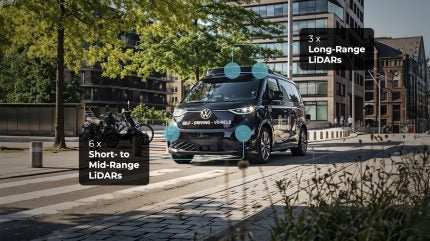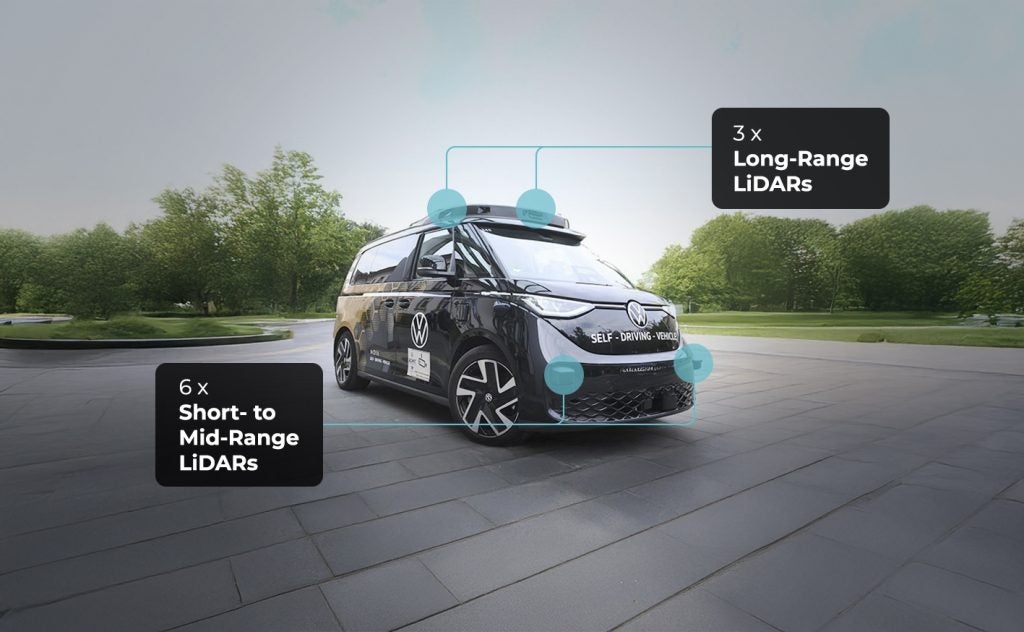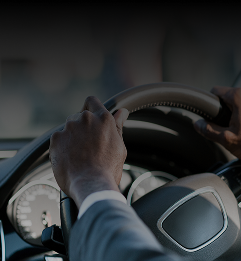
Autonomous driving tech is seeing more new solutions applied in robotaxis and busses. Uber has partnered with Volkswagen to deploy autonomous ID. Buzz AD vehicles as robotaxis in the US.
Supplier of LiDAR solutions, Innoviz, recently announced a collaboration with Volkswagen Autonomous Mobility to accelerate the integration of InnovizTwo LiDAR units into the ID. Buzz AD, VW’s L4 autonomous shuttle.
Volkswagen Autonomous Mobility, with its brand MOIA, will integrate nine Innoviz LiDARs into each ID. Buzz AD to enable advanced urban autonomous driving.
We spoke to Elad Hofstetter, chief business officer, Innoviz, to learn more about the partnership, and to discuss the testing the LiDAR technology undergoes.

Just Auto (JA): How did the company begin working with Volkswagen?
Elad Hofstetter (EH): We were nominated to work on several of the Volkswagen programs. The programs include different platforms, different vehicle types, and different applications.
There are highway applications which are L3 autonomous driving and there are also applications of L4 like the ID Buzz shuttle, which drives in urban environments.
As part of this platforms solution with Volkswagen, Innoviz is providing two LiDAR types, the InnovizTwo long range, and the InnovizTwo short range, meaning there are nine LiDARS on each vehicle.
Mobileye are also part of this program; they’re providing this solution for lots of different customers, suppliers and platforms, around the world. They’re providing their L4 platform using our LiDARs for lots of different global partners.
How is the LiDAR technology able to work in a busy, urban environment?
In a very busy environment, when there’s lots of different details, it’s important to have high resolution of the LiDAR so you can distinguish between things. Otherwise, you’ll have smearing and lots of different objects might be interpreted as one large one. You need to be able to detect vehicles, and also see the ‘cracks’- the spacing between vehicles; if a pedestrian crosses through you need to separate between this, so you need a very high and dense resolution in order to do so.
This is one of the reasons that Volkswagen have chosen our LiDAR. We provide both the large coverage of field of view (that you need to see in different parts), but can also distinguish between small obstacles, and not just large ones.

What testing did the technology undergo before deployment?
We needed to drag the LiDAR through the mud. It needs to have very rigorous environmental tests. We wanted to test it under cold conditions, warm conditions, changing conditions, rain, fog, snow, and hail. You need to test it in different environments, in different locations, because different locations have different road types and vibration profiles on the vehicle. You need to take the LiDAR to the extreme – more extreme than what the vehicles go through – in order to absolutely ensure that you can endure what the vehicles go through.
We needed to drag the LiDAR through the mud. It needs to have very rigorous environmental tests.
The vehicle will not self-drive without the LiDAR. A few months ago we did a winter campaign in which we took our LiDAR driving through Scandinavia in very harsh cold conditions, to test its functionality. We also have ovens for low and high temperature at our labs to test for all of these climate conditions.
How do you see LiDAR technology helping the next generation of vehicles?
We see it growing rapidly. In 2019 there was a lot of hype around autonomous driving, when everyone felt or thought that autonomous vehicles might be just around the corner. With time, the market and everyone realized that the reality is a little more complicated than that. Those who work in this field understood the full complexity.
Waymo announced that 22% of the drives/rides in San Francisco are with their autonomous vehicles – this is fully autonomous. This was in San Francisco, but it could be also London, Paris, or any other city; this is probably going to come faster than we expect. It doesn’t mean that tomorrow there will be only autonomous vehicles around us, but it’s coming, and this is for the L4 and the L3 as well.
To date, there are two brands with an L4 system. One of them is BMW with Innoviz, our first generation InnovizOne, and the other one is Mercedes. These are only two, but more are expected to come, but it takes time – patience is needed.
Do you see autonomous vehicles being more passenger focused or business focused?
In terms of the taxis, they’re a business case. If they get to a certain dollar per kilometre, the company can justify putting sensors and systems on a car. They’re replacing a driver, and it could drive let’s say 24/7, going for some maintenance every so often. The cost per dollar is improving over time – we can see it with Waymo.
Volkswagen and Uber are not small platforms, so these platforms are becoming more and more relevant. You need to meet the performance, you need to meet the environmental conditions, but you need to meet cost requirements. If it’s too costly, it will never play for a consumer car. But with volumes, these costs go down dramatically.
So, which will grow faster? I don’t know, but both are promising.








